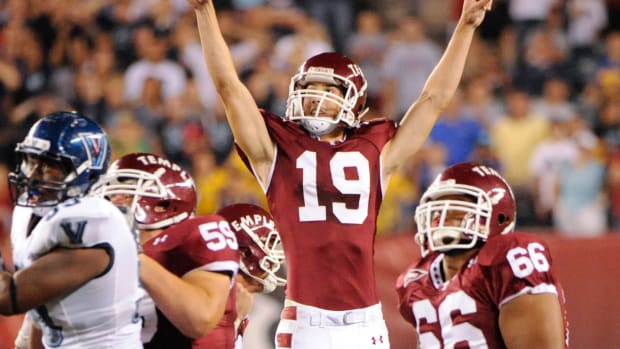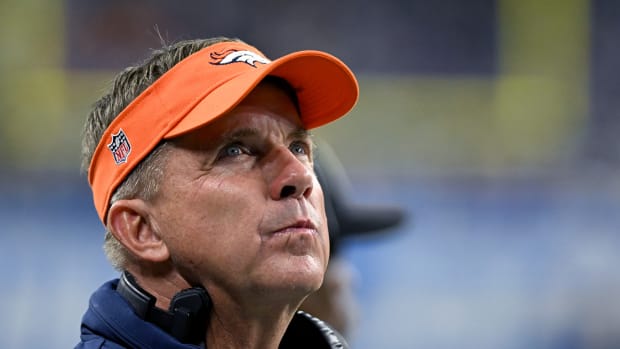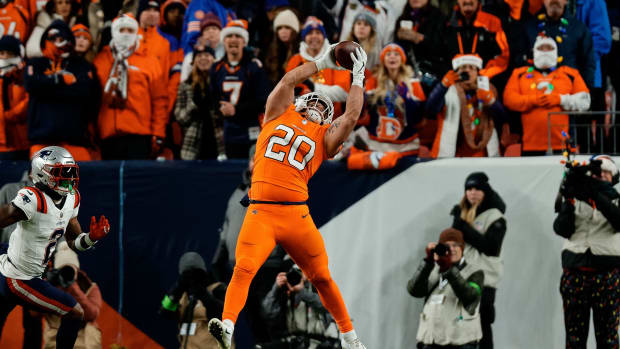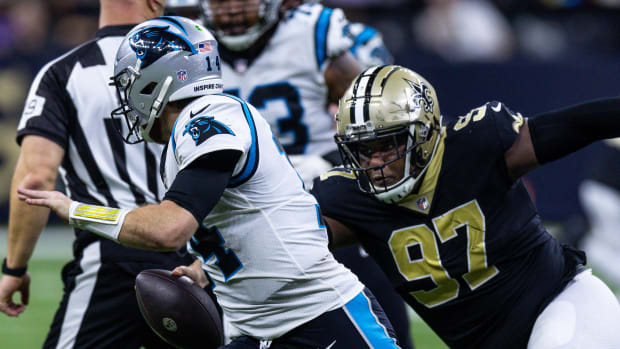Broncos' Likely Cost of Trading into Top-10 to Land Henry Ruggs III Revealed
When discussing the Denver Broncos' biggest needs going into the 2020 NFL Draft, you'll find plenty of talk about getting a wide receiver that brings speed to the offense. Wide receiver talk is followed by the belief that the top wideouts are likely gone by the time the Broncos pick at No. 15 overall.
If you believe the Broncos need to get a receiver such as CeeDee Lamb or Henry Ruggs III, you are likely to believe that GM John Elway will need to trade up. And that begs the questions; how much would the Broncos need to give up in trade to move up the board?
Roster Hints
To understand that, we need to consider where the Broncos are at with their current roster. The Broncos currently have 79 players under contract, though they can free up a roster spot or two by waiving one or both of the younger punters on the roster. But that means, at the most, the Broncos will have 13 spots available with the 90-man roster limit in place.
That brings us to the number of draft picks the Broncos currently hold, which is 10, meaning if they keep them all, the team will only have three roster spots left. That limits Denver's choices when it comes to signing undrafted rookies or adding veterans.
Of course, the Broncos can manipulate the roster as they see fit. But the fact the team is close to the 90-man roster limit for the offseason, combined with the 10 draft picks it has, tells me there's a very real chance the Broncos plan to trade up in the first round.
And for those who have their eyes on a wide receiver, it's likely the Broncos will need to jump past the Las Vegas Raiders, who draft No. 12 overall. I think it's safe to say you can rule out the following teams as trading partners: Bengals, Redskins, Lions, Giants, Dolphins and Chargers, all of whom are either looking at quarterbacks or might want to trade down with teams seeking QBs, but don't want to move too far down.
That leaves us with teams in the range of No. 7 overall to No. 11 overall, which includes the Panthers, Cardinals, Jaguars, Browns and Jets. Hence, if the Broncos trade up, they need to move anywhere from four to eight spots up the board.
What's the Damage?
How much would Denver have to give up in return for getting into the top-10?
To answer that question, I looked at past drafts since 2011, but no earlier because 2011 was when the rookie pay scale was implemented. This meant draft picks came under cost-controlled salaries and, therefore, they were more valuable when building a roster.
I looked at each move up the board in the first round, including moves in which a team traded back into the first round. I then narrowed down the list to comparable trades, in which a team either moved into the top-10 from 11-20 overall or moved up from the lower end of the top-10 (sixth to 10th) to a higher spot.
I did not examine moves in terms of whether the pick worked out or not, but in terms of the cost involved. That's because the cost involved is what matters to determine the cost the Broncos will have to pay, depending on how far up the board they trade up.
In some cases, the player in question may have driven the price up. That's especially true with quarterbacks, the position that can make or break a team. But in most cases, I didn't consider the player in question, but rather the cost to move up.
I have noted the overall pick for each trade in question, except for picks in future seasons. Though this information is known now, it wasn't known at the time the trade was made.
As an example: A team that gave up a 2013 first-round pick to move up the board in 2012 didn't know how that first-rounder would fall overall from 1 to 32. Therefore, it's not that useful to look at where the pick did fall in evaluating the trade.
I didn't assign a point value to any of the trades, but focused instead on how much draft capital and overall picks, unless it was a future pick, and how many spots the team had to move up in the first round.
Let's look at trades up the board by year, that would be comparable to the Broncos moving up the board from No. 15 overall to between No. 7 and No. 11 overall.
Trade-Up History
2011 | Jaguars-Redskins: The Jaguars got the 10th overall pick from the Redskins, moving up six spots from No. 16 overall and included a second-round pick, No. 49 overall. The Jaguars only had to include one pick, but it was a high Day 2 pick.
2012 | Jaguars-Buccaneers: The Jaguars moved up the board this year, too, getting the fifth overall pick, but moving just two spots up the board from No. 7 overall, and including a fourth-round pick, 101st overall. So this move required sending a high Day 3 pick.
2012 | Cowboys-Rams: The Rams had the sixth overall pick, then sent it to the Cowboys, who moved up eight spots up from No. 14 overall and included the 45th overall pick in the second round.
2013 | Dolphins-Raiders: The Dolphins jumped nine spots up to the third overall pick, sending the 12th overall pick and the 42nd overall pick, which was in the second round. You'll notice that, so far, we have three trades either into the top-10, or up from the lower half of the top-10 to a higher spot, that involved a second-round pick.
2013 | Rams-Bills: The Rams got the eighth overall pick from the Bills, plus the 71st overall pick, a third-rounder. The Rams moved up eight spots from No. 16, with the Bills getting that pick, plus the 46th overall pick (second round), 78th overall pick (third round) and 222nd overall pick (seventh round). A second-round pick was involved in the trade, plus the teams swapped positions in the third round.
2014 | Bills-Browns: The Bills moved up five spots from ninth to fourth overall, with the Browns getting the ninth overall pick and first- and fourth-round picks in 2015. The Bills thus gave up more future capital, rather than giving up additional picks in 2013.
2014 | Browns-Vikings: The Browns then moved one spot up from ninth to eighth, sending the Vikings the 145th overall pick, a fifth-rounder.
2016 | Titans-Browns: Of course, this was the year the Titans traded out of the No. 1 spot with the Rams, moving to No. 15 overall. The Titans then traded back into the top-10, moving up seven spots to eighth overall. The Titans sent the 76th overall pick (third round) and a second-round pick in 2017, while the Browns sent back the 176th overall pick (sixth round).
2016 | Bears-Buccaneers: The Bears jumped two spots from No. 11 to No. 9 overall, including the 106th overall pick, a fourth-rounder, in a trade with the Bucs.
2018 | Jets-Colts: The Jets jumped three spots from No. 6 to No. 3 overall. In doing so, they paid a high price: The 37th and 49th overall picks, both second-rounders, and a 2019 second-round pick went to the Colts.
2018 | Bills-Buccaneers: To move five spots from No. 12 to No. 7 overall, the Bills had to include the 53rd and 56th overall pick, both second-rounders, in the deal with the Bucs.
2018 | Cardinals-Raiders: To move five spots from No. 15 to No. 10 overall, the Cardinals had to include the 79th overall pick (third round) and 152nd overall pick (fifth round) in the deal with the Raiders.
2019 | Steelers-Broncos: Fans no doubt remember this move, in which the Steelers jumped 10 spots from No. 20 to No. 10 overall. Other picks sent to the Broncos were the 52nd overall pick (second round) and a 2020 third-rounder.
Narrowing it Down
In examining the trades above, the ones that would be the most comparable, in terms of the spots the Broncos would have to jump from No. 15 to No. 7-11 overall, would be Jaguars-Redskins in 2011, Cowboys-Rams in 2012, Rams-Bills in 2013, Titans-Browns in 2016, Bills-Buccaneers in 2018 and Cardinals-Raiders in 2018.
All but one of these trades involved at least one second-round pick and, in one of those trades, it was a future second-rounder.
So it would appear that the Broncos will likely have to include a second-round pick to complete the trade, no? Well, perhaps not. Because the Broncos have three third-round picks this year and could package two together instead of a second-rounder.
Such a trade might mean the Broncos have to include a Day 3 pick this or next year, or perhaps they could throw in a player on the current roster they don't intend to keep. But it isn't necessarily true that the Broncos have to include a second-rounder — the draft capital the Broncos have means they might not have to give that up to jump a few spots.
Most Likely Partners
But let's now look at the teams in question who the Broncos have to trade with in order to get past the Raiders and consider who is most likely to deal with the Broncos.
First, I think you can rule out the Jets at No. 11 overall because there is reportedly still hard feelings between head coach Adam Gase, who appears to have greater say in personnel decisions now, and Broncos' GM John Elway.
If that's still the case, the Jets may ask for too much to move up or may not even talk at all. Perhaps I'm wrong, but for the time being, I'm ruling that option out.
Second, I don't think the Panthers at No. 7 overall or the Jaguars at No. 9 overall will trade down. They could be looking at quarterbacks in this year's class as much as they are thinking about the 2021 QB class.
Plus these teams are rebuilding and, if they aren't targeting this year's QBs, are likely looking at other players who can be building blocks and won't want to trade out of the top 10.
That leaves the Cardinals at No. 8 overall and the Browns at No. 10 overall. The Cardinals have just five picks, but the price to get that pick is likely to be a bit higher.
Perhaps the Broncos could get the Cardinals to take the Broncos third-round picks at No. 77 and No. 83 overall, plus the fourth-round pick at No. 118 overall and throw in CB Isaac Yiadom. The selling point is that the Cardinals need more draft capital and would get a player who has played in Vance Joseph's defensive scheme before.
If the Broncos really want a receiver that badly, they might have to give the Cardinals their second-round pick, No. 46 overall, and the highest of the third-round picks. The question I would ask before giving up a second-rounder, though, comes down to whether the Broncos are convinced that, say, the Jaguars are targeting a wide receiver and/or that the Cardinals really want one of the top options, but would be fine with moving down if they get a pick that allows them to get a good option in the second round.
If a receiver the Broncos like is still on the board at No. 10 overall, the Browns come into play and I think that's the team Elway stands the best chance of completing a trade with.
The Browns could still find a player at No. 15 overall who would fill one of their top needs and they don't have to move too far down the board. Plus, the Broncos should be able to keep the price at two third-rounders, perhaps those at No. 77 and No. 95 overall. While that would be more than what the Cardinals sent to the Raiders in 2018, two third-rounders may very well get the Browns to accept.
Bottom Line
Assuming Ruggs is on the board at No. 10 overall, a trade with the Browns makes sense. The Broncos shouldn't have to give up too much draft capital to move up five spots, ensuring they still have enough capital left to address other positions.
Of course, it's going to depend on how the draft falls early on. There could be other teams looking to move up the board for a receiver, too. The Raiders have draft capital to work with and could be poised to jump up the board, with the idea that a team moving down would still be drafting 11th overall.
But if the Broncos do want to trade up, the good thing is that they have the draft capital to spare. The trades I've mentioned should give you the idea of the price to move up the board.
Thus, it's a question of how the board falls and what moves happen on draft day. If things fall into place, it just might be in the Broncos' best interest to trade up.
Follow Bob on Twitter @BobMorrisSports and @MileHighHuddle.




